Russia's placement of its nuclear arsenal on high alert during the war in Ukraine has unearthed fears of nuclear holocaust. As governments across the world consider their own roles in lessening the risk of nuclear war, the U.S. cannot excuse itself. We should talk about stemming a future nuclear impact, but equally important is reckoning with our past.
Between 1946 and 1958 the U.S. nuclear testing program drenched the Marshall Islands with firepower equaling the energy yield of 7,000 Hiroshima bombs. Cancer rates have doubled in some places, displaced people have waited decades to return to their homes, and radiation still plagues the land and waters of this Pacific island nation. The U.S. must prioritize the restoration of these islands and the resettlement of their people as a matter of human rights and environmental justice. What the U.S. has done so far is simply not enough.
The tests most gravely affected four atolls in the north of the nation: Bikini (seen here in 1946), Enewetak, Rongelap and Utirik. In the first two cases, members of the U.S. military resettled communities prior to testing, whereas people on Rongelap and Utirik left after fallout from tests reached them. Today only Enewetak and Utirik have substantial permanent populations; refugees from Bikini and Rongelap are still unable to return home safely.
In addition, the structural integrity of the Runit Dome, a concrete shell covering more than 100,000 cubic yards of nuclear waste on an island of Enewetak Atoll, is at risk because of rising sea levels. Leakage from the dome will likely increase, and higher tides threaten to break the structure open.
To better understand the effect of nuclear testing on the islands, scientists at the Department of Energy have conducted a wide range of studies. We believe their work has missed critical pieces. Rather than taking simple, direct measurements of gamma radiation, the DOE has consistently relied on simulations. Still, the military has notably cleaned up some parts of Enewetak Atoll.
For several years our group has gone to the Marshall Islands to research the fallout of this nuclear testing. We have published our findings to ensure that independent information exists to safeguard the well-being of affected communities.
Considerable contamination remains. On islands such as Bikini, the average background gamma radiation is double the maximum value stipulated by an agreement between the governments of the Marshall Islands and the U.S., even without taking into account other exposure pathways. Our findings, based on gathered data, run contrary to the DOE's. One conclusion is clear: absent a renewed effort to clean radiation from Bikini, families forced from their homes may not be able to safely return until the radiation naturally diminishes over decades and centuries.
Beyond plutonium and uranium, strontium 90 is a radioisotope of concern in the Marshall Islands. It can cause leukemia and bone and bone marrow cancer and has long been a source of health concerns at nuclear disasters such as Chernobyl and Fukushima. Despite this, the U.S. government's published data don't speak to the presence of this dangerous nuclear isotope.
We have tested sediment from two bomb craters in the northern Marshall Islands and found consistently high values of strontium 90. Although detecting this radioisotope in sediment does not neatly translate into contamination in soil or food, the finding suggests the possibility of danger to ecosystems and people.
More than that, cleaning up strontium 90 and other contaminants in the Marshall Islands is possible. Congress should appropriate funds, and a research agency, such as the National Science Foundation, should initiate a call for proposals to fund independent research with three aims. We must first further understand the current radiological conditions across the Marshall Islands; second, explore new technologies and methods already in use for future cleanup activity; and, third, train Marshallese scientists, such as those working with the nation's National Nuclear Commission, to rebuild trust on this issue.
Through the collective work of dozens of researchers rather than a small group of scientists at the DOE, remediation efforts across the world will benefit. The Marshallese people and other affected communities have told us for decades just how dangerous nuclear weapons are. Let's heed their warnings before it is too late.
JOIN THE CONVERSATION ONLINE Visit Scientific American on Facebook and Twitter or send a letter to the editor: editors@sciam.com

